Plays staged at the National Theatre in Belgrade have left their mark on the theatre scene in the recent years. The National Theatre houses three ensembles under its roof – the Drama, the Opera, and the Ballet—the first of them has earned a name as the very best of not just Serbian but regional (ex-Yugoslav) theatre. For theatre connoisseurs in the region this is certainly an interesting phenomenon.
The National Theatre was founded in 1868, and until the end of WWII was the only professional theatre in Belgrade to have uninterruptedly continued work. After the war, numerous new theatres were opened there and in other towns in Serbia, some of which boasted a very modern contemporary repertoire. The focus of cultural attention naturally shifted to these theatres, while the National Theatre mostly held the status of a relatively conservative “keeper of national values,” as is often the case with national institutions in the sphere of arts and culture.
It is definitely worth mentioning that there have been several more or less successful attempts to modernize the Drama department of the National Theatre but they mostly failed to bring it among the top-ranking stages on either the Serbian or former-Yugoslav scene. This finally happened only recently, with the rise of the Drama department that started in 2015.
There were several circumstances in play. Primarily, there was the appointment of a new agile head of the Drama: the dramaturg Željko Hubač, who held this position from 2014 until the end of 2018. Then there were the financial conditions, which cannot be said to have been completely favorable but were at least slightly less bad than in many other theatres across Serbia during the last several seasons. In addition, there were other more general circumstances: since the beginning of 21st c., there have been some changes in the aesthetic paradigm on the Serbian theatrical scene, and this indirectly led to the modernization of the Drama department of the National Theatre. The shift in paradigm refers to a host of authors of the young and middle generations becoming established—authors whose aesthetics are in line with the latest dramatist and staging practices. Naturally, the influence of BITEF (Belgrade International Theatre Festival) was a significant contributor to the acceptance of the new practices, as the festival has been continually held in Belgrade since 1967, and its impact has been especially strong on the younger generations of theatre people, since they have been artistically formed as “children of BITEF.”
The rise of the National Theatre’s Drama department continued unflagging in the next few seasons. It staged a series of successful plays based on domestic, foreign, classic and contemporary texts, thus rising to the top of the Serbian theatre. However, along with its success on national level, it also – for perhaps the first time in its history – became the very center of the regional (ex-Yu) scene. Therefore, several months ago (at the end of 2018), the decision to replace its head Hubač caused one of the biggest revolts of both actors and the theatre-going public in Serbia, and the fired head as well as the Drama company members enjoyed the support of numerous colleagues from Serbia and former Yugoslav republics. Here are some of the most successful plays staged by the company that are still part of the current repertoire of the National Theatre.
The first among them is The Patriots (2015) based on the text by Jovan Sterija Popović (herein: Sterija) and directed by Andras Urban (b. 1970). The play has a special position in the history of Serbian drama. Sterija (1806-1856) was the most important Serbian playwright of the 19th c. and was also a social reformer in various fields, such as education, culture, and politics. His literary opus is an unusual mixture of the past, present, and future, and his comedies have been a constant presence on Serbian stages. Given the time of its inception (mid-19th c,), The Patriots is a bitter and cruel comedy with a curiously modern structure. There is no single ‘isolated’ classic drama hero, the protagonists are a group of small town middle-class citizens, Serbs from Vojvodina – a territory which is now the northern Serbian province but which belonged to Austria-Hungary in the 19th c.. These characters declaratively subscribe to the idea of patriotism and represent the interests of the Serbian nation but they do this in an extremely hypocritical and inconsistent manner. In practice, their patriotic leanings boil down to personal greed and their patriotism serves as a cover for financial gain. The text was based on the turbulent events of 1848 in European history and the author stated in its introduction that nothing had been invented. In the midst of political turmoil between the Hungarians and the court in Vienna, the group of false Serbian patriots keep changing political positions for personal material gain.

Patriots. Photo Credit: Vojka Nikačević.
Due to this sensitive content the play was first performed only half a century later and has enjoyed a masterpiece status in Serbian literature ever since. But its author Sterija, one of the classics of Serbian literature, is virtually unknown outside of Serbia and former Yugoslavia. There are two predominant reasons for this. One would refer to the so-called small language and culture issues, which as a rule means more difficulty in achieving international recognition. The second reason pertains to the very language Sterija’s plays were written in. The language has a distinct flavor and is full of old-fashioned, local, and freshly-coined words. The play’s title itself is a neologism, made with minimum language intervention on the word and concept of patriote (the patriots). The original title in the Serbian language Rodoljupci also has an ironic connotation and refers to the notion of false patriotism; the specific word, being a neologism, was inadequately translated into both French and English (The Patriots, Les patriotes). It is likely that Jovan Sterija Popović himself coined the word Rodoljupci as an analogy with srebroljupci (Eng. ‘covetous (People),’ a reference to the New Testament, Timothy 3.
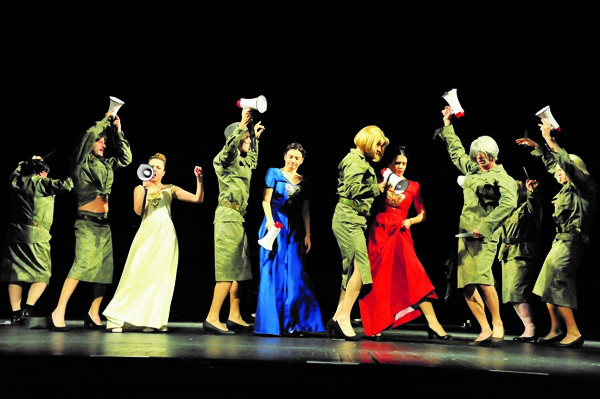
Patriots. Photo Credit:Vojka Nikačević.
The idea that Andras Urban should be the director to stage this provocative play on pseudo-patriotism among Serbs carried a certain risk with it: Urban is a Hungarian living in Subotica, a town in the north of Serbia close to the Serbian-Hungarian border. No less provocative was the venue where the play was to be performed: the National Theatre has been, from its establishment, envisaged as a platform to promote national values, and not question them in provocative and radical ways. On its stage, this play by Sterija had only been performed twice, in the first half of the 20th c.. Moreover, the topic of pseudo-patriotism in the entire region, including Serbia, had become especially topical after the break-up of Yugoslavia in 1991. In the wars waged in former Yugoslavia during the 1990s, the political elites manipulated the issues of nationality and carried out economic re-composition on a huge scale – i.e. formed a completely new financial elite class of society. Numerous social problems remained unsolved even following the break-up of the former country, with the topic of pseudo-patriotism remaining present in public discourse, regardless of the fact that there are no more wars in the region. Thus the bitter comedy by Sterija has remained relevant in an almost fascinating manner. It seems as if the characters have just stepped from the pages into the real world.
One of the first provocative scenes in the play is set in a church, which is not a venue mentioned in the original text and is a part of Urban’s directorial concept. The church as an institution represents the idea of ‘togetherness’ (national unity) of the Serbs and the character of the priest represents the hypocrisy of the church. Urban develops the scene further in that the characters speak and chant (as part of the service) not in Serbian, but in some made-up Hungarian, which sounds authentic, on top of it. After all, if we have pseudo-patriots, why couldn’t we have a pseudo-language in one of the scenes?
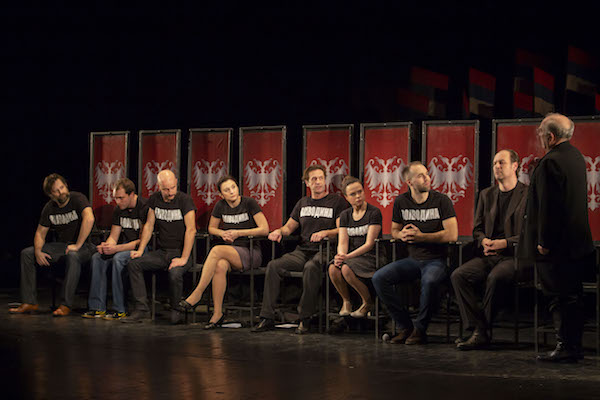
Patriots. Photo Credit:Vojka Nikačević.
On the minimalist (relatively empty) stage, this ironic treatment of national myths continues in a brisk, vigorous manner which breaks with realistic staging conventions. The Patriots-men thus at one point dress, wearing make up and wigs, not only as women but also as women wearing costumes resembling military fatigues to boot. This travesty can be interpreted as an expression of animalistic, Amazonian, or even Bacchanal nature of these characters, since in the drama text they call for war and clashes of nations. At a deeper, psychoanalytical level, this kind of director’s concept could refer to the issue of their hidden, latent sexual proclivities. The creativity and eclectic style of costumes is also apparent in the final part of the production when the Patriots finally achieve material gain and wear an unusual combination of Serbian national costume (simple attire of ordinary people from the past) and costly, contemporary fur coats.
Urban’s use of songs is of special importance, since they are not part of the play, but they function in the performance according to the Brechtian theatre concept. These songs, therefore, underscore the critical treatment of the subject, and the social and ideological dimension of the play. This is particularly obvious in the witty, ironic group song in which the names of almost all contemporary Serbian politicians are mentioned, regardless of their ideology (left or right wing): to the rhythm of rap music, after each politician’s name, the same verse is repeated, (he/she) ‘is right.’
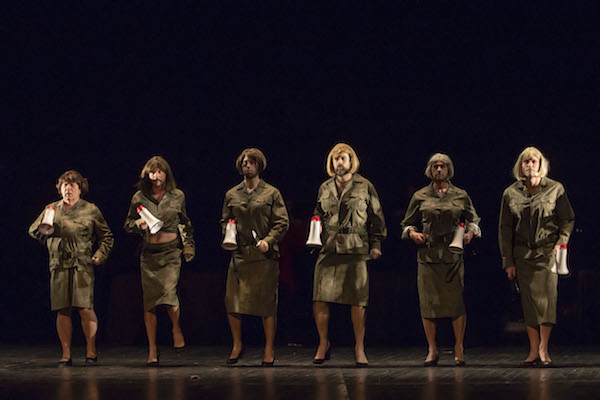
Patriots. Belgrade. Photo Credit:Vojka Nikačević.
Nevertheless, the most radical moment in the production comes when a maddened group of false patriots kills Gavrilović, the character whose purpose in this play is unsuccessfully attempting to be the voice of reason. This event completes the re-coding of the play’s basic genre pattern and the bitter comedy and satire by Sterija turns into a tragedy. Regardless of the fact that this murder is not in the original text, recent experiences during the wars in former Yugoslavia point to the fact that this kind of director’s concept can be justified by the political reality, since (as is usually the case) the numerous deaths of innocent people were the most tragic consequences of these wars.
The cast greatly contributes to the success of Urban’s production, bringing to it the spirit of unity and an energetic and modern artistic expression. The excellent text of one of the classics of Serbian drama, the modern direction, and the willingness of the cast to participate in this radical staging concept all contributed to The Patriots receiving affirmative reviews and a string of festival awards both in Serbia and in the region.
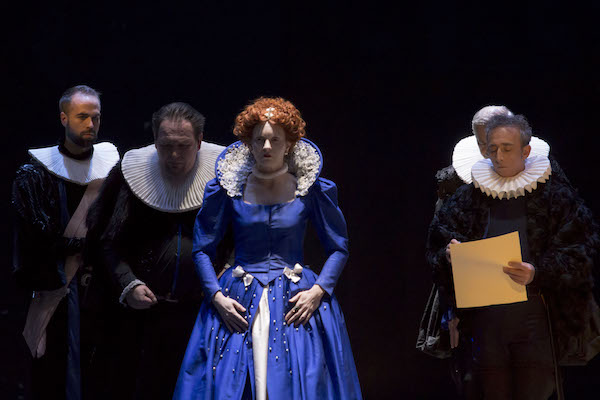
Mary Stuart. Photo Credit:Vojka Nikačević.
Another play that has been enjoying a similar success is Mary Stuart, based on the text by Friedrich Schiller and directed by Miloš Lolić. The works of Schaller have had a long tradition of being performed at the National Theatre in Belgrade. It is also worth mentioning that Lolić (b. 1979) is one of the few Serbian directors who have become well-known even outside of Serbia and the region. In recent years he has been successfully working on European stages, especially in Germany and Austria. In his direction of Mary Stuart, Lolić uses the fact that both protagonists (Elizabeth the Queen of England and Mary the Queen of Scots) are women as the point of departure. In his reading of the play, they are equal opponents, both in their strength and their belonging to the same generation. With such characteristics, at the beginning they both have equal chances of becoming queen. However, they are the embodiments of two different principles. Mary Stuart is passionate, livelier and freer in manner than her rival and that is likely why she makes some mistakes that the more pragmatic and cool-headed Elizabeth avoids. The key conflict of the two rulers happens in the scene where they wrestle in the mud. This kind of dramatic resolution is based on the idea of a male-centered system, which leaves room for the two women to fight, although the central conflict is initiated by men.
The director reads the play as a “perverted game,” a daring phantasmagorical reconstruction of an actual conflict from history. He does not make any direct comparisons to current political events. On the contrary, he underlines what Schiller reminds us of – namely, that the court has always been a place where people live in fear, passion, betrayal, loneliness, and with vested interests… Just as it is in the original, politics is the fundamental issue of the production but it touches on many other issues. This is a vicious circle: politics leads to the topic of male-female relationships and then the story circles back to the political sphere.

Mary Stuart. Photo Credit:Vojka Nikačević.
The stage is half-dark, the characters enter and exit quietly and cautiously, as if everyone is spying on everyone else. The spatial positioning for the character of imprisoned Mary Stuart is especially intriguing: during a large chunk of the production she is in a hole on the stage, with the upper half of her body sticking out.
Visually speaking, this is a highly aesthetic, sophisticated production, with elaborate costumes corresponding to the historical era – Elizabeth is in a blue period dress and Mary Stuart in a black one. The two main female protagonists are played by excellent actresses, Nada Šargin (Elizabeth) and Sena Đorović (Mary Stuart). In this cast, Mary Stuart appears to have the iron strength, passion, and energy enough to triumph over her opponent. However, she is prevented from doing that due to her imprisonment. Conversely, Elizabeth is outwardly cold but she is careful almost to the point of paranoia. Elizabeth is portrayed by a physically petite and fragile actress of modern artistic expression, who has won several awards for this masterful portrayal of her character.
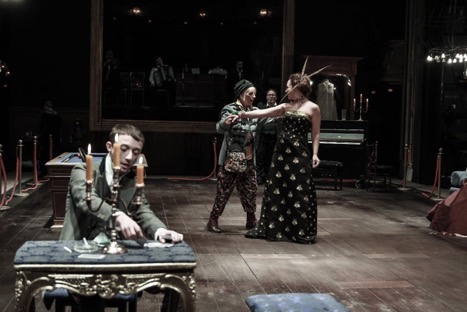
Ivanov. Photo Credit:Vojka Nikačević.
Yet another successful production of the National Theatre is Ivanov by A. P. Chekhov, directed by Tatjana Mandić Rigonat (b. 1965). In it the audience is on the stage, surrounding the actors on three sides. On the fourth side—the one facing the hall—is a small orchestra which plays music during the performance. Tatjana Mandić Rigonat explores the play as if conducting an archeological excavation into the human soul. The spatial organization – the audience being quite close to the actors – highlights the intimate atmosphere of the play.
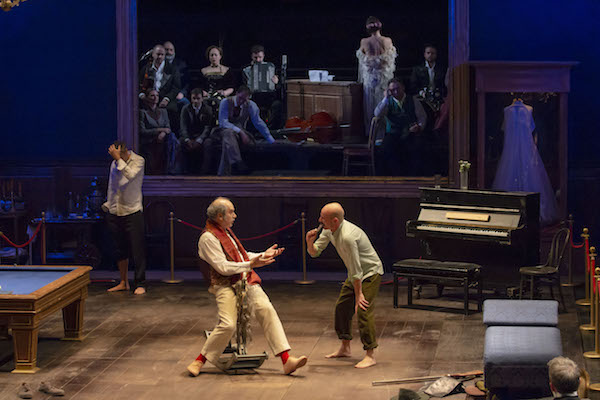
Ivanov. Photo Credit:Vojka Nikačević.
As a director, Mandić Rigonat is known for her studious, serious interpretation of dramatic texts, especially the classics. This has also been her approach to Ivanov, where she has tried to embody on the stage the psychological and emotional complexity of Chekhov’s characters in minute detail. She has been successful, naturally, only with the help of dedicated and inspired actors necessary for this kind of intimate stage concept. The title role of Ivanov, an idealist disappointed by himself and the world, is played by Nikola Ristanovski, a guest actor from Macedonia who often appears in the stages of Belgrade – and is one of the leading actors in the region. “He is the best and the most handsome Ivanov I have ever seen,” wrote a critic after a guest performance of the Belgrade theatre in Zagreb (Croatia). Anna Petrovna (played by above-mentioned Nada Šargin) and Sasha (Hana Selimović) are also worth mentioning as being among the other very well-played roles.

Ivanov. Photo Credit:Vojka Nikačević.
Note:
This text was written as part of project Identity and Memory: Transcultural Texts of Drama Arts and Media (Serbia 1989-2014) (project no 178012), at the Faculty of Dramatic Arts in Belgrade, supported by the Ministry of Education, Science and Technological Development of the Republic of Serbia.
Ksenija Radulović, PhD, is Associate Professor at the Faculty of Dramatic Arts, University of Arts in Belgrade, teaching History of Theatre and Drama. She was Director of the Museum of Theatre Arts of Serbia and editor-in-chief of the journal Teatron (2001 – 2012). She was also the artistic Director of Sterijino pozorje festival, which is the leading national theatre festival in Serbia (2010-2012). In 2009 she was the curator of Serbia focus programme at the New Drama Festival in Bratislava, Slovakia, and in 2007 she was the selector of Show case – Bitef / Belgrade International Theatre Festival. She writes regilarly articles and reviews for Serbian and international journals and, since 2018, she’s Vice-Editor-in-Chief of Anthology of Essays by FDA (Faculty of Dramatic Arts)

European Stages, vol. 13, no. 1 (Spring 2019)
Editorial Board:
Marvin Carlson, Senior Editor, Founder
Krystyna Illakowicz, Co-Editor
Dominika Laster, Co-Editor
Kalina Stefanova, Co-Editor
Editorial Staff:
Joanna Gurin, Managing Editor
Maria Litvan, Assistant Managing Editor
Advisory Board:
Joshua Abrams
Christopher Balme
Maria Delgado
Allen Kuharsky
Bryce Lease
Jennifer Parker-Starbuck
Magda Romańska
Laurence Senelick
Daniele Vianello
Phyllis Zatlin
Table of Contents:
- Introductory Note by Kalina Stefanova.
- “Andrzej Tadeusz Wirth (1927 – 2019) – White on White” by Krystyna Illakowicz.
- Lithuanian Marriage in Warsaw or The Last Production of the Great Eimuntas Nekrošius by Artur Duda.
- “My, Żydzi polscy [We, Polish Jews]”: A Review of Notes from Exile by Dominika Laster.
- A Report on the State of Our Society, According to Jiří Havelk in The Fellowship of Owners at VOSTO5, Prague, and Elites, at the Slovak National Theater, Bratislava by Jitka Šotkovská.
- About Life as Something We Borrow. On the Stages of Pilsen (In the 26 th edition of the International Theatre Festival There) by Kalina Stefanova.
- Redesigning Multiculturalism or Japanese Encounters in Sibiu, Romani, The Scarlet Princess, written and directed by Silviu Purcărete, inspired by Tsuruya Namboku IV’s Sakura Hime Azuma Bunshô by Ion M. Tomuș.
- About Globalization: A “Venice Merchant” on Wall Street, at the Hungarian Theatre of Cluj in Romania by Maria Zărnescu.
- The Patriots, Mary Stuart and Ivanov and the Rise of the Drama Ensemble of the National Theatre in Belgrade by Ksenija Radulović.
- The Unseen Theatre Company or How to See Beyond the Visible: The Shadow of My Soul and the Theatre of Velimir Velev by Gergana Traykova.
- Multilingual Pirandello, Understandable to Everyone: The Mountain Giants at the Croatian National Theatre “Ivan pl. Zajc”, Rijeka by Kim Cuculić.
- The return of the repressed: the ghosts of the past haunt Barcelona’s stages by Maria M. Delgado.
- A poetics of memory on the Madrid stage (2018) by Maria M. Delgado.
- The Danish National Theatre System and the Danish National School of Performing Arts: December in Copenhagen 2018 by Steve Earnest.
- Towards a Theatre of Monodrama in Turkey 1 by Eylem Ejder.
- Where Is Truth? Justiz by Friedrich Dürrenmatt, adapted and directed by Frank Castorf at the Schauspielhaus Zürich by Katrin Hilbe.
- Report from Vienna by Marvin Carlson.
www.EuropeanStages.org
europeanstages@gc.cuny.edu
Martin E. Segal Theatre Center:
Frank Hentschker, Executive Director
Marvin Carlson, Director of Publications
©2019 by Martin E. Segal Theatre Center
The Graduate Center CUNY Graduate Center
365 Fifth Avenue
New York NY 10016
European Stages is a publication of the Martin E. Segal Theatre Center ©2019
Martin E. Segal Theatre Center:
Frank Hentschker, Executive Director
Marvin Carlson, Director of Publications
©2019 by Martin E. Segal Theatre Center
The Graduate Center CUNY Graduate Center
365 Fifth Avenue
New York NY 10016
European Stages is a publication of the Martin E. Segal Theatre Center ©2019




